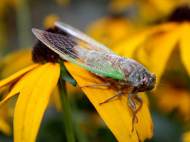Cicada wing surface biomimicry could lead to anti-bacterial surfaces
 While many research groups throughout the world seek for better ways to fight bacteria, an international research group of researchers Australia’s Swinburne University of Technology and Spain’s Universitat Rovira i Virgili investigated cicada insect and came up with a discovery that may lead to a surface able to destroy bacteria solely through its physical structure.
While many research groups throughout the world seek for better ways to fight bacteria, an international research group of researchers Australia’s Swinburne University of Technology and Spain’s Universitat Rovira i Virgili investigated cicada insect and came up with a discovery that may lead to a surface able to destroy bacteria solely through its physical structure.
The clanger cicada (Psaltoda claripennis) is a locust-like insect whose wings are covered by a vast hexagonal array of nanopillars which aid in insect’s fight against bacteria – one of the first natural surfaces found to do so. Although it seems as the texture layout could be puncturing bacteria, this bed of nails made of nanopillars actually does not puncture the bacterial cells on first contact.
When a bacterium settles on the wing surface, its cellular membrane gets “grabbed” by these nanopilars, thus sticking to the surface. After sticking to the surface of nanopillars, the surface of bacterium stretches into the gaps between them. As you can see in the video bellow, bacteria membrane ruptures if its surface is soft and thin enough.
“The rupturing effect is more like the stretching of an elastic sheet of some kind, such as a latex glove. If you take hold of a piece of latex in both hands and slowly stretch it, it will become thinner at the center, [and] will begin to tear”, said Elena Ivanova, Professor of Bionanotechnology at the Swinburne University of Technology and lead author of the study.
Ivanova and her team irradiated bacteria with microwaves to generate cells that had different levels of membrane rigidity in order to test their hypothesis that the more rigid bacteria would be less likely to rupture between the nanopillars. The results confirmed the model and demonstrated that the cicada’s nanopillar defense couldn’t be used for general fight against bacteria, but rather a fight against bacteria with sufficiently soft membranes.
Swinburne University of Technology researchers claim that they need to study cicada’s wing before its physical-defense properties can be mimicked in man-made materials. These materials could be used on public surfaces that commonly harbor disease, such as bus railings, thus significantly cutting costs for maintenance and environmental impact of detergents uses during their cleaning.
Once further researched and perfected to become more efficient against tougher membranes, the surface could act as be combined with coatings which don’t allow bacteria to stick to surfaces. The surface with nanopillars could be used as “drains” where bacteria unable to stick to coated surfaces can stick to. Aside acting as passive bacteria-killing surface for bacteria with suitable membranes, it could be replaceable and cleaned with microwaves and sterilized for reuse.
For more information, read the paper published in the Biophysical Journal: “Biophysical Model of Bacterial Cell Interactions with Nanopatterned Cicada Wing Surfaces”









Leave your response!